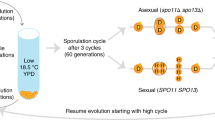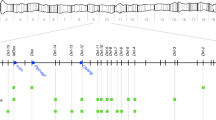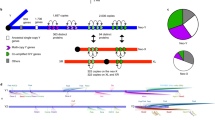Abstract
What advantage might sexual recombination confer? Population genetics theory predicts that asexual genomes are less efficient at eliminating deleterious mutations and incorporating beneficial alleles1,2. Here, I compare patterns of genome evolution in a 40-kb gene-rich region on homologous neo-sex chromosomes of Drosophila miranda3. Genes on the non-recombining neo-Y show various signs of degeneration, including transposable-element insertions, frameshift mutations and a higher rate of amino-acid substitution. In contrast, loci on the recombining neo-X show intact open reading frames and generally low rates of amino-acid substitution. One exceptional gene on the neo-X shows evidence for adaptive protein evolution, affecting patterns of variability at neighboring regions along the chromosome. These findings illustrate the limits to natural selection in an asexual genome. Deleterious mutations, including repetitive DNA, accumulate on a non-recombining chromosome, whereas rapid protein evolution due to positive selection is confined to the recombining homolog.
This is a preview of subscription content, access via your institution
Access options
Subscribe to this journal
Receive 12 print issues and online access
$209.00 per year
only $17.42 per issue
Buy this article
- Purchase on Springer Link
- Instant access to full article PDF
Prices may be subject to local taxes which are calculated during checkout


Similar content being viewed by others
References
Barton, N.H. & Charlesworth, B. Why sex and recombination? Science 281, 1986–1990 (1998).
Felsenstein, J. The evolutionary advantage of recombination. Genetics 78, 737–756 (1974).
Bachtrog, D. & Charlesworth, B. Reduced adaptation of a non-recombining neo-Y chromosome. Nature 416, 323–326 (2002).
Rice, W.R. Experimental tests of the adaptive significance of sexual recombination. Nat. Rev. Genet. 3, 241–251 (2002).
Maynard Smith, J. The Evolution of Sex (Cambridge University Press, Cambridge, 1978).
Bell, G. The masterpiece of nature (University of California, Berkeley, 1982).
Charlesworth, B. & Charlesworth, D. The degeneration of Y chromosomes. Philos. Trans. R. Soc. Lond. B Biol. Sci. 355, 1563–1572 (2000).
Bull, J.J. Evolution of Sex Determining Mechanisms (Benjamin Cummings, Menlo Park, California, 1983).
MacKnight, R.H. The sex-determining mechanism of Drosophila miranda. Genetics 24, 180–201 (1939).
Steinemann, M. & Steinemann, S. Enigma of Y chromosome degeneration: neo-Y and neo-X chromosomes of Drosophila miranda a model for sex chromosome evolution. Genetica 102-103, 409–420 (1998).
Rice, W.R. Evolution of the Y sex chromosome in animals. BioScience 46, 331–343 (1996).
Bachtrog, D. & Charlesworth, B. Reduced levels of microsatellite variability on the neo-Y chromosome of Drosophila miranda. Curr. Biol. 10, 1025–1031 (2000).
Orr, H.A. & Kim, Y. An adaptive hypothesis for the evolution of the Y chromosome. Genetics 150, 1693–1698 (1998).
Bachtrog, D. & Charlesworth, B. On the genomic location of the exuperantia 1 gene in Drosophila miranda—the limits of in situ hybridisation experiments. Genetics (in the press).
Adams, M.D. et al. The genome sequence of Drosophila melanogaster. Science 287, 2185–2195 (2000).
Li, W. Molecular evolution (Sinauer Associates, Sunderland, Massachusetts, 1997).
Bachtrog, D. Accumulation of spock and worf, two novel non-LTR retrotransposons on the neo-Y chromosome of Drosophila miranda. Mol. Biol. Evol. 20, 173–181 (2003).
Kimura, M. The Neutral Theory of Molecular Evolution (Cambridge University Press, Cambridge, 1983).
Steinemann, M. & Steinemann, S. Degenerating Y chromosome of Drosophila miranda: a trap for retrotransposons. Proc. Natl. Acad. Sci. USA 89, 7591–7595 (1992).
McDonald, J.H. & Kreitman, M. Adaptive protein evolution at the Adh locus in Drosophila. Nature 351, 652–654 (1991).
Hudson, R.R., Kreitman, M. & Aguade, M. A test of neutral molecular evolution based on nucleotide data. Genetics 116, 153–159 (1987).
Maynard Smith, J. & Haigh, J. The hitch-hiking effect of a favourable gene. Genet. Res. 23, 23–35 (1974).
Tajima, F. Statistical method for testing the neutral mutation hypothesis by DNA polymorphism. Genetics 123, 585–595 (1989).
Rice, W.R. Degeneration of a nonrecombining chromosome. Science 263, 230–232 (1994).
Rice, W.R. & Chippindale, A.K. Sexual recombination and the power of natural selection. Science 294, 555–559 (2001).
Parisi, M. et al. Paucity of genes on the Drosophila X chromosome showing male-biased expression. Science 299, 697–700 (2003).
Carvalho, A.B. Origin and evolution of the Drosophila Y chromosome. Curr. Opin. Genet. Dev. 12, 664–668 (2002).
Ohno, S. Evolution by gene duplication (Springer, Berlin, 1970).
Acknowledgements
I am grateful to P. Andolfatto, B. Charlesworth and S. Wright for discussion and comments on the manuscript. This work was supported by a European Molecular Biology Organisation postdoctoral fellowship and a Royal Society research grant.
Author information
Authors and Affiliations
Ethics declarations
Competing interests
The author declares no competing financial interests.
Rights and permissions
About this article
Cite this article
Bachtrog, D. Adaptation shapes patterns of genome evolution on sexual and asexual chromosomes in Drosophila. Nat Genet 34, 215–219 (2003). https://doi.org/10.1038/ng1164
Received:
Accepted:
Published:
Issue Date:
DOI: https://doi.org/10.1038/ng1164
This article is cited by
-
Genomic structure and evolution of the mating type locus in the green seaweed Ulva partita
Scientific Reports (2017)
-
How to make a sex chromosome
Nature Communications (2016)
-
Transposable elements and early evolution of sex chromosomes in fish
Chromosome Research (2015)
-
Y-chromosome evolution: emerging insights into processes of Y-chromosome degeneration
Nature Reviews Genetics (2013)
-
Organelle DNA accumulation in the recently evolved papaya sex chromosomes
Molecular Genetics and Genomics (2013)



